SEO
Free SEO Analysis
SEO Services
Content Marketing Services
Local SEO
Link Building Services
Specialized SEO Services
PPC
REPUTATION MANAGEMENT
Free Reputation Management Analysis
Reputation Management Services
Review Management Services
Specialized Reputation Management Services
CEO Reputation Management
Brand Enhancement
Business and Directory Listings
Comprehensive Reputation Management Audit
SOCIAL MEDIA
Free Social Media Analysis
Specialized Social Services
WEB DEVELOPMENT
Free Website Analysis
Web Design Services
Mobile Development Services
Website Maintenance Services
Specialized Development Services
MARKETING AUTOMATION
Free Marketing Automation Analysis
Specialized Marketing Automation Services
Comprehensive Marketing Automation
INDUSTRIES
ABOUT DMA
PPC, Social Media
12 Common Facebook Ad Mistakes (And How to Avoid Them)
Request a quote
Its Fast, Easy & Free
Executive Summary
- Facebook has more than 2.5 billion active monthly users. That’s a lot of people to potentially get your ad in front of.
- To get the most out of your advertising, you’ll want to test out different types of audiences to find out what works for your particular business.
- If your landing pages don’t fit with your ad design, you’re going to confuse people.
If you’ve spent any amount of your marketing budget on Facebook ad campaigns that don’t get you anything in return, this is the article for you.
Facebook advertising can be a great way to generate leads and conversions, but you have to do it the right way.
Unfortunately, there are common Facebook ad mistakes that many marketers make. This leads to Facebook ad campaigns that fall flat, getting lots of impressions without conversions.
In this article, we’re going to cover the most common Facebook advertising mistakes marketers make, plus what you can do to avoid or fix them.
Let’s get started!
12 Facebook Ad Mistakes You Can Avoid
Facebook has more than 2.5 billion active monthly users. That’s a lot of people to potentially get your ad in front of.
But if you’re making these mistakes, your Facebook ad campaigns aren’t going to end well.
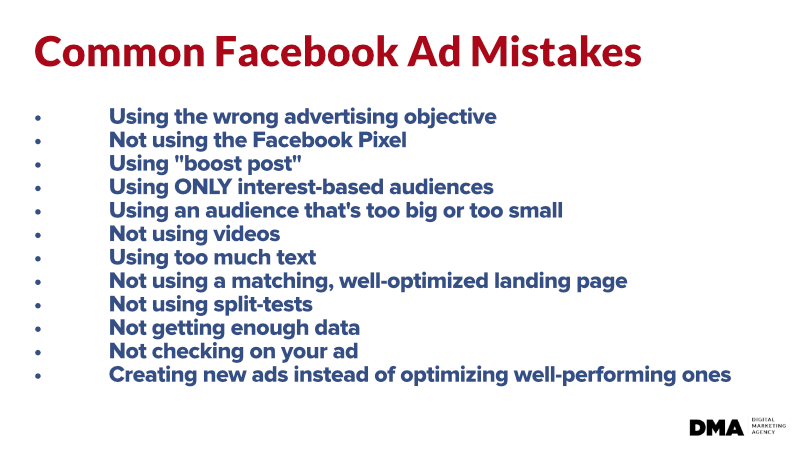
Facebook Ad Mistakes
Let’s take a look at 12 common Facebook advertising mistakes and how you can do things differently for better results.
1. Using the Wrong Objective
You choose a campaign objective right at the start of your ad-building process and it really drives your entire Facebook ad campaign. Your objective lets the platform know what you want to achieve from your Facebook advertising campaign and helps you get there.
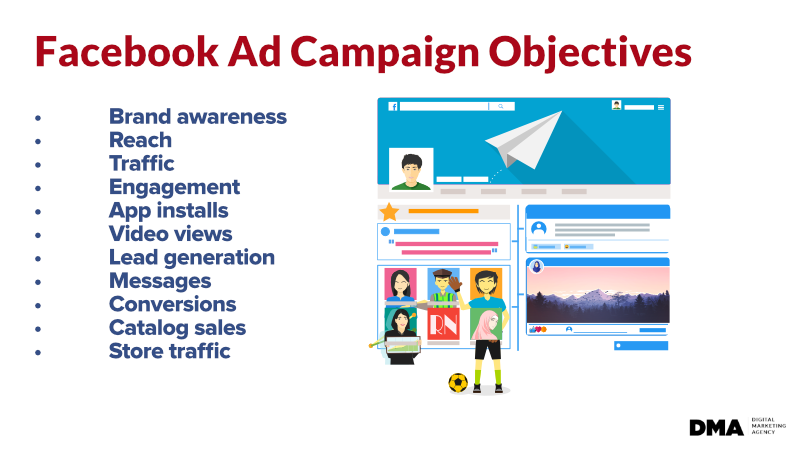
Facebook has 11 campaign objectives:
Brand awareness:
Increase awareness of your business, brand, or service.
Reach:
Show your ad to as many people as possible in your target audience.
Traffic:
Send traffic from Facebook to any URL, such as your website's landing page, a blog post, app, etc.
Engagement:
Reach those more likely to engage with your post. Engagement includes likes, comments, and shares but can also include offers claimed from your page.
App installs:
Send people to the store where they can download your business's app.
Video views:
Share videos with people on Facebook most likely to watch it.
Lead generation:
. Create ads that collect info from people interested in your product, such as sign-ups for newsletters.
Messages:
Connect with people on Messenger, Instagram Direct, and WhatsApp. Communicate with potential or existing customers to encourage interest.
Conversions:
Encourage people to take a specific action on your business's site, such as having them to add items to a cart, download your app, register for your site, or make a purchase.
Catalog sales:
Show products from your catalog to generate sales.
Store traffic:
Promote your brick-and-mortar business locations to people that are nearby.
Take the time to choose the right campaign objective instead of one that might work. If your ads aren’t getting results, your objective is the first thing to check.
2. Not Using the Facebook Pixel
Facebook Pixel is a short snippet of code you can add to your website to track and analyze the behavior and actions of your site visitors. The pixel continuously works to collect valuable data about your audience.
The data that the pixel collects can be used to track events, create custom audiences, retarget users based on their actions, optimize conversion campaigns, create lookalike audiences, and a lot more.
3. Using “Boost Post”
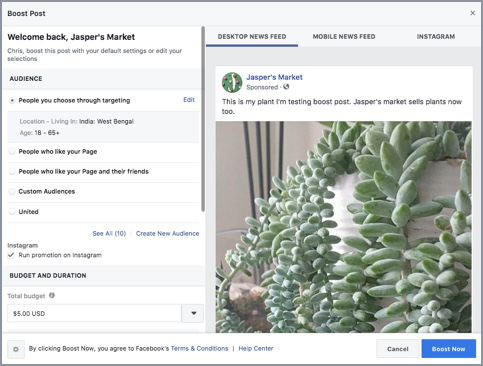
If you’ve spent any amount of time on Facebook as a business owner, you’ve seen the “Boost Post” option underneath the posts you make on your business’s Facebook page.
It’s tempting, we know.
Facebook tells you how many 1,000s of people you’re going to be able to reach if you boost your post—why wouldn’t you do it?
While this will show off that post to potential customers, it’s not going to do much else.
Before you’re tempted to click on “Boost Post,” create an advertising account on the platform that will really make a positive difference to your bottom line.
4. Using Only Interest-Based Audiences
Interest-based audiences are a great place to start, but to get the most out of your advertising, you’ll want to test out different types of audiences to find out what works for your particular business.
We recommend trying out interest-based audiences to gather information about what works and what doesn’t so you can put that data to use with custom audiences and lookalike audiences.
5. Using a Too Big or Too Small Audience
Another common Facebook ad mistake deals with audience size.
There aren’t any cut-and-dried rules about what size audience you should be targeting. It really depends on your Facebook advertising objective, industry, and budget.
We recommend aiming for an audience size of 500K–2 million. If you have a larger budget, you can target more (2.5 million or so).
Obviously, you’ll need to adjust these numbers for your business. Businesses with a small audience and budget (like a local business) will have a smaller audience size.
Why is audience size so important?
If your Facebook ad audience is too small you’re going to have a hard time spending your advertising budget. Or, your ad is going to show up too often for users, causing them to be annoyed or stop seeing it altogether due to ad fatigue.
If your audience is too big you’re going to be spending a whole lot of money reaching people who aren’t actually qualified.
6. Not Using Videos
Everyone loves videos. They’re engaging—yes, even in ads. Videos will keep the attention of users for a lot longer than images. And this gives you a better chance of getting your advertising message through.
Facebook loves video ads, too; they know how they work to keep users on their platform longer.
Bottom line, if you’re not using videos in your Facebook ads, you’re missing out.
The best part about video is that it’s no longer the huge production that it used to be.
Many marketers don’t have access to a professional camera or recording equipment, but it doesn’t matter. Even the camera on your smartphone will work to create a high-quality video you can use in your ads.
There’s also editing software and tutorials that make it super easy to edit your video into something you’re proud of.
When considering creating a video for your Facebook ads, take the time to plan out your story and make it something that you would actually pay attention to. If you’d watch it, other people will, too!
7. Using Too Much Text on Your Ad Images
Facebook used to flat out specify that an ad image with more than 20% text was a no-no. If your ad image contained more than 20% text, you’d get an email letting you know that your ad needed to be fixed before it could be approved.
These days, Facebook uses categories (Low, OK, Medium, and High) to classify their text-in-images rule.
Unfortunately, with this new application of its text-in-images rule, Facebook isn’t going to decline your ad. No, they’re just going to reduce your ad’s reach. A low text-in-images classification is going to have a normal reach, but reach will start to decrease as your ad has a higher text-to-image ratio.
This is a common Facebook ad mistake that has a simple solution: keep text in your ad images to a minimum.
Facebook offers a Text Overlay Tool that will help you make sure that your ad doesn’t have too much text.
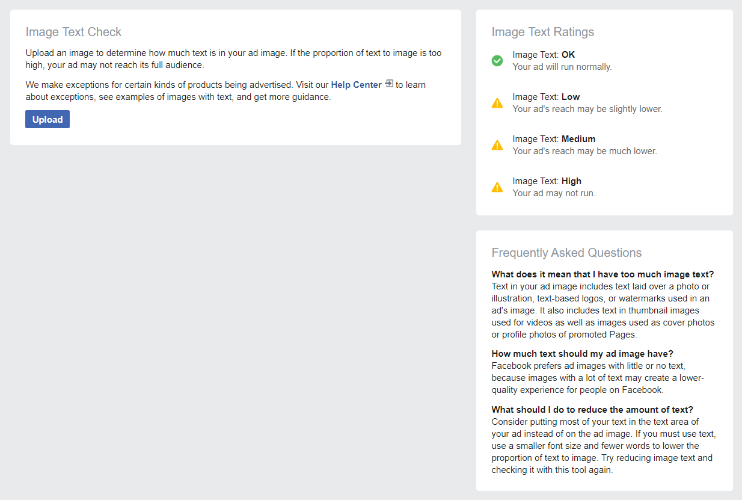
8. Not Using a Landing Page (or Using a Non-Optimized Landing Page)
This Facebook ad mistake is common across paid advertising platforms.
No matter how much time you’ve taken to create a great ad experience, sales happen on the page you send your ad traffic to. If your landing pages don’t fit with your ad design, you’re going to confuse people.
And confused people don’t buy products or sign up for newsletters from companies that confuse them.
Keep your ads and landing pages coordinated—images, fonts, colors, everything! This helps you create a cohesive message that conveys a level of quality and attention-to-detail that your audience will appreciate.
9. Not Using Split Tests for Your Creative
Many advertisers think that okay results are great… because they don’t split test.
Any ad is probably going to get you some positive results, even if it doesn’t have a great ROI. But, don’t make the Facebook ad mistake of just running and running ads without running split tests that will help you optimize them.
You can split-test just about anything, but we recommend split testing your creative and getting your message optimized before moving on to other tests.
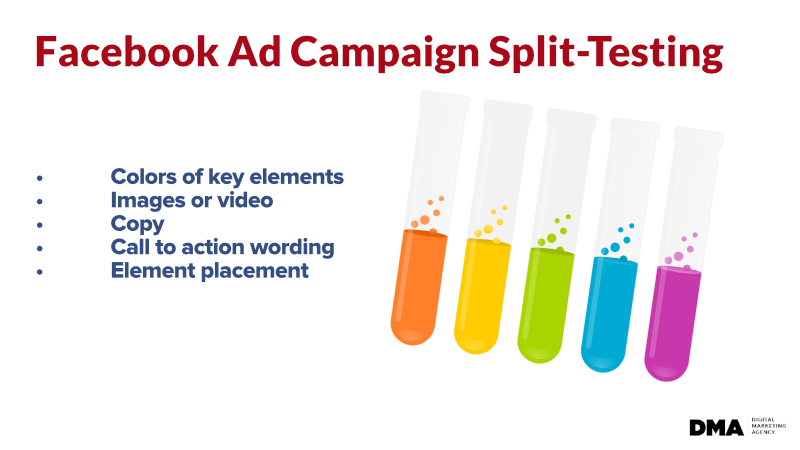
Here are a few of the things you can do when split testing your creative:
Colors of key elements (does a blue or green call to action button convert better?)
Images or video
Copy
Call to action wording (do people respond better to “Sign Up” or “Subscribe?”)
Element placement (does having the signup form on the right or left side of the page work better?)
Split tests will not only help you optimize your ad creative but will also help you understand your audience even better. When you know how your audience responds to different creative, you can use this knowledge to create better ad campaigns in the future.
Of course, you’ll want to be intentional with your testing. This means not testing everything all at the same time. Change just one or two elements and run your test for a while to get a decent sample size before choosing the winner. Then, make changes to the winner and test again!
10. Not Getting Enough Data
This just might be the most potentially damaging Facebook ad mistake marketers make.
There’s this misconception that if you create an ad that’s good it should just start converting and stay converting. Some marketers will start running an ad campaign, not get a sale in a day, and change the ad (or stop running ads altogether because “they don’t work”).
Stop doing that.
If you don’t let your ad run long enough, you don’t know that it’s working. This is where the Facebook pixel comes in handy.
Facebook needs around 50–100 conversions every week in order to optimize its conversions algorithm. If you’re not making enough sales, the campaign won’t perform the way you want.
But how do you get the data you need without spending tons of money on conversion for purchase campaigns?
Hold off on those campaigns until you’ve collected enough data. You can always run other campaigns until you have the budget to get the conversions you need for a conversion to purchase campaign.
11. Not Checking In
This Facebook ad mistake is easy to remedy.
Just remember that Facebook ads are not a “set it and forget it” thing. Even if you have a perfectly optimized ad, if you’re not analyzing your ad’s performance and making tweaks, you’re probably not getting the most out of your ad.
No matter what type of campaign you’re running and why, how much you’re spending, or who your target audience is, you need to check in on your ad.
12. Creating New Ads When Your Campaigns Are Working
You’ve found the sweet spot. You have a responsive audience, leads are rolling in, you’re getting conversions.
Are you really going to create a new ad?
Hopefully, you’d be surprised at how prevalent this Facebook ad mistake is among more experienced advertisers.
If you have an ad that’s performing well, take the time to analyze it. Is there anything you can do to further optimize the ad? Is there anything you want to test?
It’s much better to analyze, optimize, and test your existing ads that are performing well instead of creating entirely new ads.
Conclusion
It’s not hard to get a good response from your Facebook advertising campaigns. By knowing and understanding the most common Facebook ad mistakes, you can avoid those Facebook Ad Mistakes and create ads that wow your audience, drive traffic, generate leads, and boost sales.
Are you serious about getting the best results from your Facebook advertising efforts? Hire an expert! Here are the best Facebook advertising companies right now.
Our Sales team